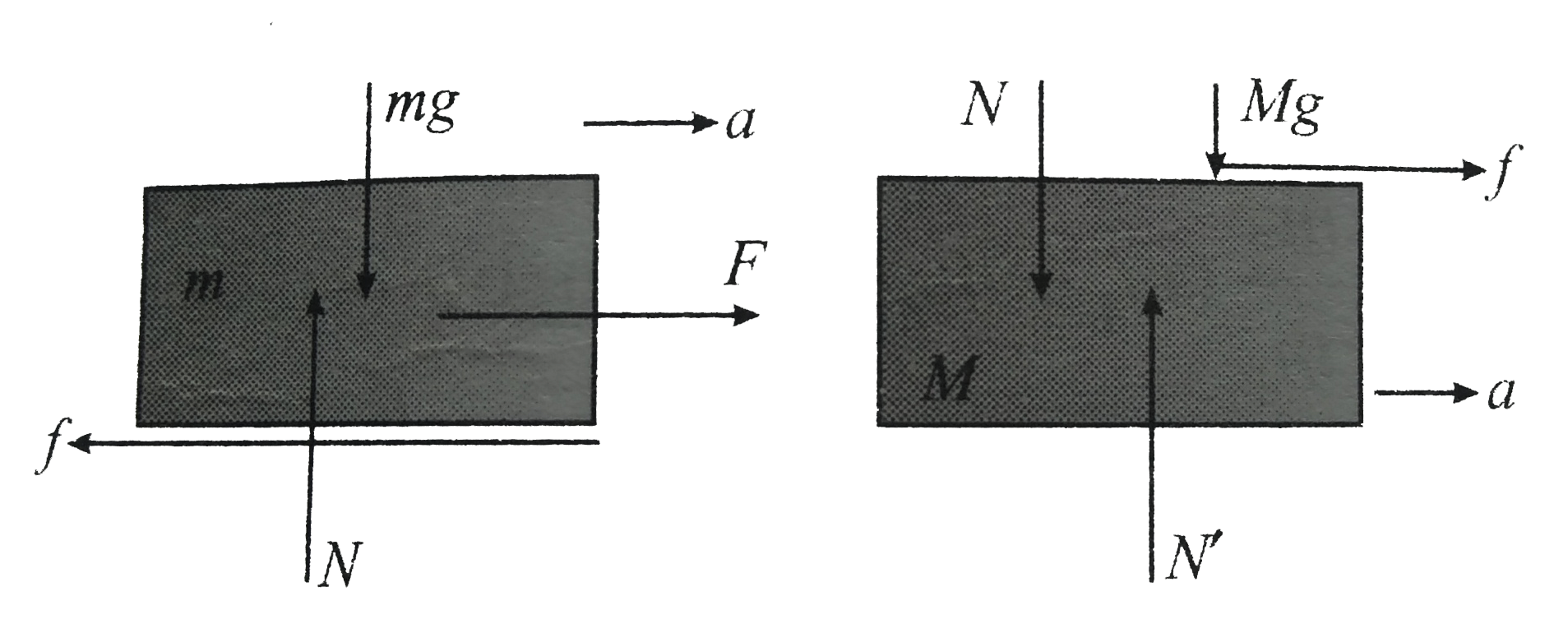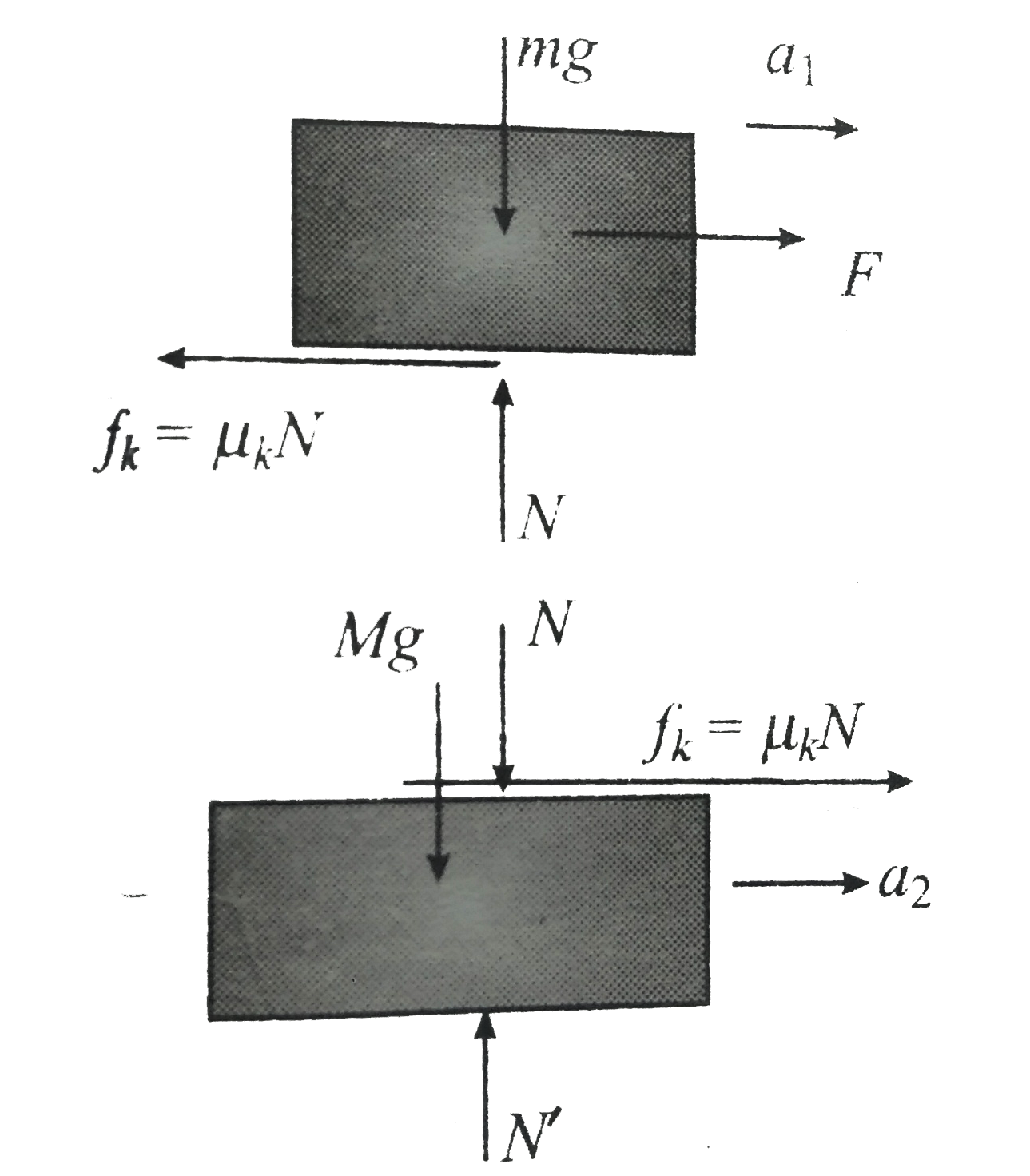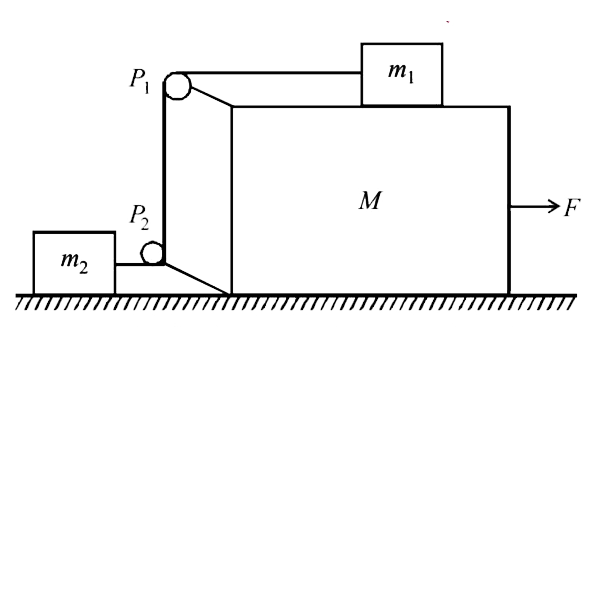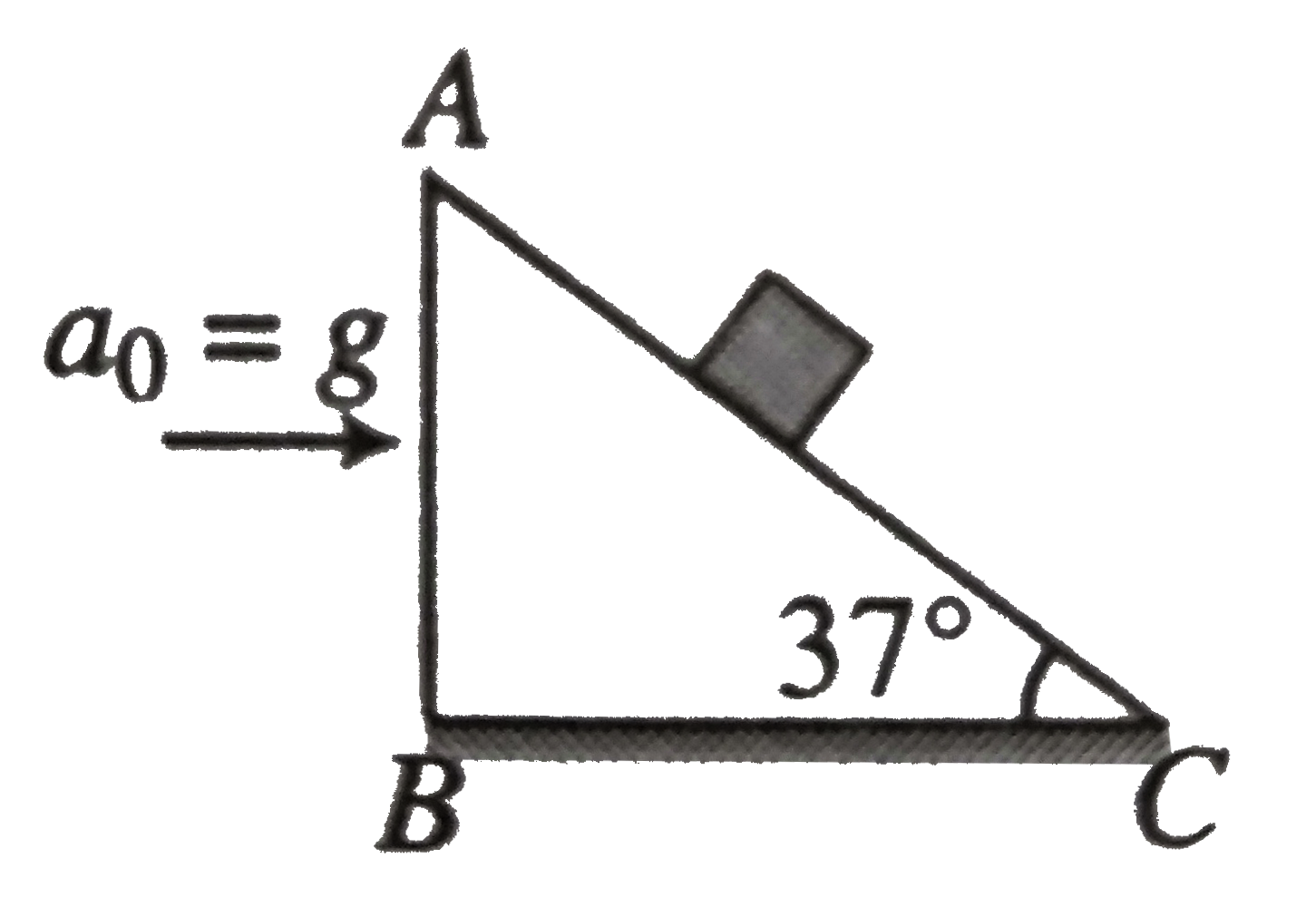Let as consider the next case in the previous illustration when there is no friction between ground and . The coefficient of static and kinetic friction are and , respectively, and force acts upper block as shown in figure
a. What is the maximum possible value of so that the system moves together ?
b . If there is releative sliding between and then calculate acceleration of and

Let the system move together , then
of and
From of ….(i)

As there is no sliding between and
If the relative sliding between the blocks starts . The friction force between the block will be of kinetic nature and both blocks will move with different accelerations.

Acceleration of
Acceleration of
Topper's Solved these Questions
- NEWTON'S LAWS OF MOTION 2BOOK - CENGAGE PHYSICSCHAPTER - NEWTON'S LAWS OF MOTION 2EXERCISE - Solved Examples
12 Videos
- NEWTON'S LAWS OF MOTION 2BOOK - CENGAGE PHYSICSCHAPTER - NEWTON'S LAWS OF MOTION 2EXERCISE - Exercise 7.1
25 Videos
- NEWTON'S LAWS OF MOTION 1BOOK - CENGAGE PHYSICSCHAPTER - NEWTON'S LAWS OF MOTION 1EXERCISE - Integer
5 Videos
- PROPERTIES OF SOLIDS AND FLUIDSBOOK - CENGAGE PHYSICSCHAPTER - PROPERTIES OF SOLIDS AND FLUIDSEXERCISE - INTEGER_TYPE
2 Videos
Similar Questions
In the figure masses m1, m2 and M are 20 kg, 5kg and 50kg respectively. The coefficient of friction between M and ground is zero. The coefficient of friction between m1 and M and that between m2 and ground is 0.3. The pulleys and the strings are massless. The string is perfectly horizontal between P1 and m1 and also between P2 and m2. The string is perfectly vertical between P1 and P2. An external horizontal force F is applied to the mass M. Take g=10m/s2.

(a) Draw a free body diagram for mass M, clearly showing all the forces.
(b) Let the magnitude of the force of friction between m1 and M be f1 and that between m2 and ground be f2. For a particular F it is found that f1=2f2. Find f1 and f2. Write equations of motion of all the masses. Find F, tension in the spring and acceleration of masses.
View SolutionA block weighing 20N rests on a horizontal surface . The coefficient of static friction between the block and surface is 0.4 and the coeffiecient of kinetic frictioni 0.20
a.How much is the friction force excerted on the block?
b. How much will the friction force be if a horizontal force of 5N is exerted on the block?
c. What is the minimum force that will start the block in motion ?
d. What is the minimum force that will keep the block in motion once is has been started ?
e. If the horizontal force is 10N what is the friction force?
View SolutionA block is placed on an inclined plane moving towards right horizontally with an acceleration a0=g. The length of the plane AC=1m. Friction is absent everywhere. Find the time taken (in seconds) by the block to reach from C to A.

View SolutionTwo soap bubbles A and B are kept in a closed chamber where the air is maintained at pressure 8N/m2.The radii of bubbles A and B are 2cm and 4cm, respectively. Surface tension of the soap-water used to make bubbles is 0.04N/m. Find tha ratio nB/nA, where nA and nB are the number of moles of air in bubbles A and B, respectively. [Neglect the effect of gravity.]
View SolutionThe coefficient of static friction between the two blocks shown in figure is μ and the table is smooth. What maximum horizontal forced F can be applied to he block of mass M so that the block move together?

View SolutionTwo blocks M and m are arranged as shown in the diagram The coefficient of friction between the block is mu_(1) = 0.25 and between the ground and M is mu_(2) = (1)/(3) If M = 8 kg then find the value of m so that the system will remain at rest
View SolutionConsider the situation as shown in the figure. If mu_(1) is the friction coefficient between block A and incline and mu_(2) is the friction coefficient between block B and incline. Find the acceleration of block A if (a) mu_(1) = (1)/(5) , mu_(2) =(2)/(5) and (b) mu_(1) = (2)/(5) , mu_(2) = (1)/(5) .
View SolutionThe coefficient of friction between the blocks are mu_(s) = 0.3 and mu_(k) = 0.2 . (a) Find the maximum value of F so that the blocks move together. (b) If force F is twice the value found in (a) , find the acceleration of each block.
View SolutionA block of mass M is sliding down the plane. Coefficient of static friction is mu_(s) and kinetic friction is mu_(k) . Then friction force acting on the block is :
View SolutionA block of mass m2 is placed on a horizontal table and another block of mass m1 is placed on top is it. An increasing horizontal force F=αt is exerted on the upper block but the lowwer block never moves as a result. If the coefficient of friction between the blocks is μ1 coefficient of friction between the blocks is μ1 and that between the lower block and the table is μ2, then what is the maximum possible value of μ1/μ2 ?
View SolutionCoefficient of kinetic friction and coefficient of static friction between two blocks is μk and μs respectively. In general
View Solutionचित्र में, फर्श तथा गुटके B के मध्य घर्षण गुणांक 0.1 है। गुटके B व A के मध्य घर्षण गुणांक 0.2 है। A का द्रव्यमान m/2 व B का द्रव्यमान m है। गुटके B पर क्षैतिज बल F अधिकतम कितना लगाया जा सकता है ताकि दोनों गुटके एक साथ खिसके?

View SolutionA block of mass m is placed behind in contact with vertical side of M as shown in the figure. The coefficient of static friction between m and M in μ. The least horizontal force with which m can be pushed so that the two blocks move together is (neglect friction between M and ground).
View SolutionThe coefficient of static friction between the two blocks shown in figure is μ and the table is smooth. What maximum horizontal forced F can be applied to he block of mass M so that the block move together?

View SolutionThe coefficient of static friction between the two blocks shown in figure is μ and the table is smooth. What maximum horizontal forced F can be applied to he block of mass M so that the block move together?

View Solution
